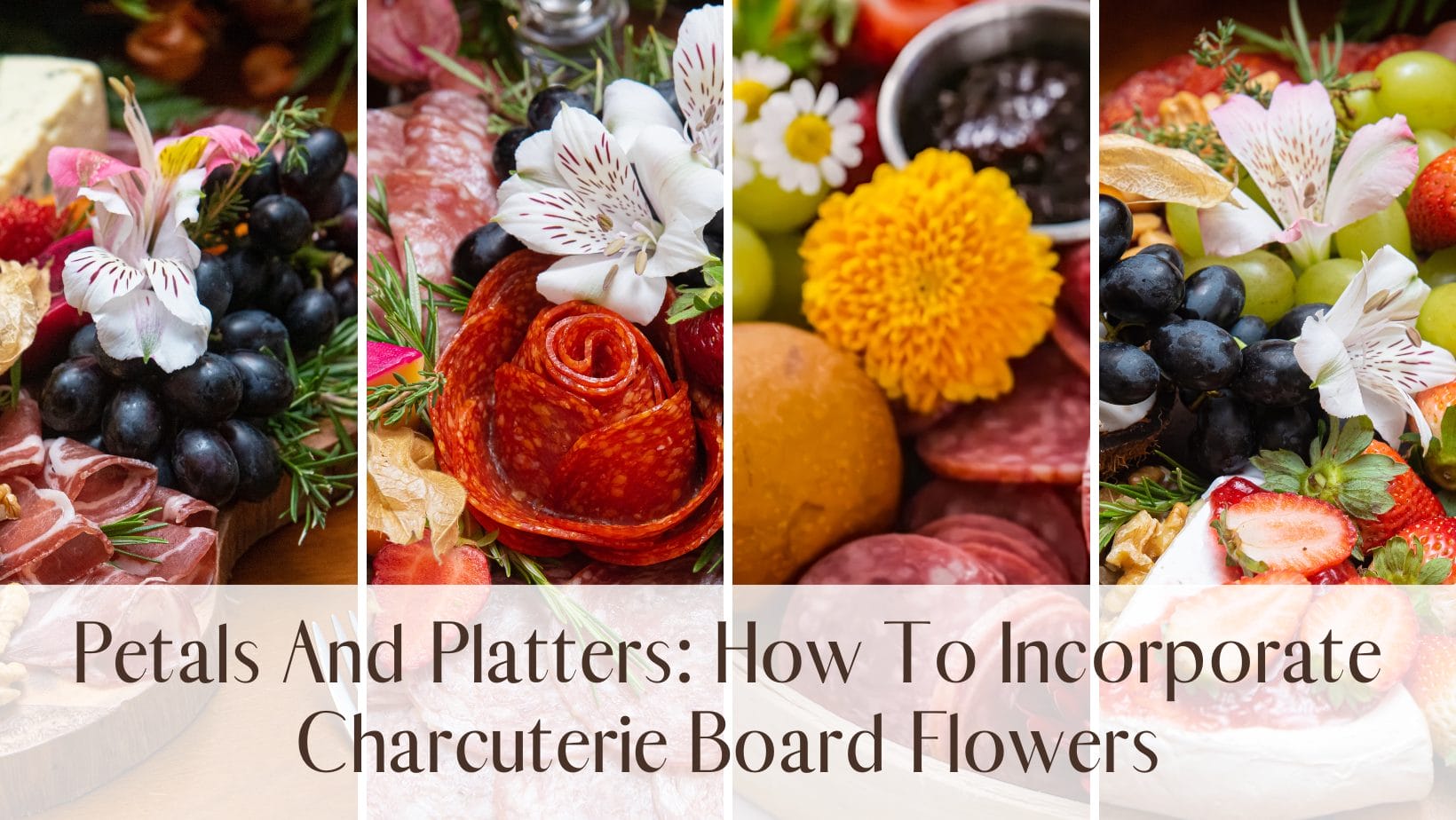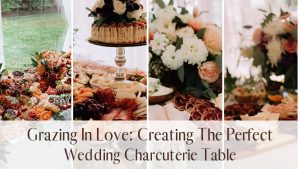Charcuterie boards have become the star of gatherings, transforming ordinary snacks into visually stunning culinary displays. Imagine taking your charcuterie board to the next level with the addition of beautiful, delicate flowers. Not only do they add a burst of color and elegance, but edible flowers can also introduce unique flavors and aromas. In this guide, we'll explore the art of incorporating flowers into your charcuterie board, offering tips on everything from flower selection to creative decoration ideas. Get ready to impress your guests with a floral touch that turns your charcuterie board into a masterpiece.
TIP: Become a charcuterie artist with the help of 514K enthusiasts and professionals. Click here for quick, easy lessons and community support >>
Table of Contents [CLICK HERE TO OPEN]
- Why Use Flowers on Charcuterie Boards?
- Types of Edible Flowers for Charcuterie Boards
- How to Decorate Your Charcuterie Board with Flowers
- Best Flowers for Charcuterie Boards
- Combining Edible Flowers and Herbs
- Floral Arrangement Tips for Charcuterie Boards
- DIY Charcuterie Board Decoration Ideas
- Wrapping It Up
- Frequently Asked Questions
Why Use Flowers on Charcuterie Boards?
Flowers add a vibrant and sophisticated touch to any charcuterie board. Their natural colors and delicate petals can transform a simple arrangement of meats, cheeses, and accompaniments into a visually stunning centerpiece. Here are some specific aesthetic benefits:
- Color and Contrast: Flowers introduce a range of colors that can complement the hues of meats, cheeses, fruits, and nuts. Bright flowers like pansies, marigolds, and nasturtiums can provide striking contrasts that catch the eye.
- Visual Interest: The unique shapes and textures of flowers add depth and complexity to the presentation. This variety can break the monotony of uniform slices of cheese and meat, making the board more engaging to look at.
- Focal Points: Strategically placed flowers can act as focal points, guiding the viewer’s eye across the board. This can help highlight specific sections or specialty items, creating a more intentional and artful layout.
- Elegance and Sophistication: Flowers inherently carry a sense of elegance and sophistication. Incorporating them into your charcuterie board can elevate the overall presentation, making it look professional and carefully curated.
The Flavor Enhancements Provided by Edible Flowers
Edible flowers do more than just look good; they can also enhance the flavors of your charcuterie board. Here’s how:
- Unique Flavors: Many edible flowers have distinctive flavors that can complement and enhance the taste of cheeses, meats, and other accompaniments. For example, nasturtiums have a peppery taste that pairs well with creamy cheeses, while violets can add a sweet, floral note.
- Aromatic Qualities: Flowers such as lavender and rosemary blossoms bring aromatic elements to the board, engaging multiple senses and enhancing the overall tasting experience.
- Flavor Pairing: Edible flowers can be paired with specific items on the board to create unique flavor combinations. For instance, the mild, sweet flavor of pansies can balance the saltiness of cured meats, while the citrusy tang of begonia flowers can complement aged cheeses.
- Garnishes and Condiments: Flowers can be used to infuse honey, vinegars, or oils, creating custom condiments that add another layer of flavor to the board. These infused elements can be drizzled over items or served in small dishes for dipping.
The Growing Trend of Using Flowers in Culinary Presentations
The use of flowers in culinary presentations is a growing trend, driven by several factors:
- Visual Appeal: In the age of social media, particularly platforms like Instagram and Pinterest, visually striking food presentations are highly popular. Flowers naturally lend themselves to creating photogenic dishes that are often shared and admired online.
- Health and Wellness: Edible flowers are often associated with natural and organic food trends. Many people are increasingly interested in incorporating fresh, natural ingredients into their diets, and flowers fit well into this trend.
- Culinary Innovation: Chefs and home cooks alike are constantly seeking new ways to innovate and distinguish their dishes. Edible flowers offer a novel and versatile ingredient that can be used in various ways to add creativity and uniqueness to culinary creations.
- Event and Party Planning: Flowers are commonly used in event and party planning for their decorative qualities. Incorporating them into charcuterie boards is a natural extension of this practice, enhancing the thematic and visual elements of gatherings and celebrations.
Incorporating flowers into charcuterie boards is not just a fleeting trend but a growing movement that blends visual beauty, flavor enhancement, and innovative culinary practices. Whether for a casual get-together or a sophisticated event, flowers can elevate the humble charcuterie board to a feast for both the eyes and the palate.
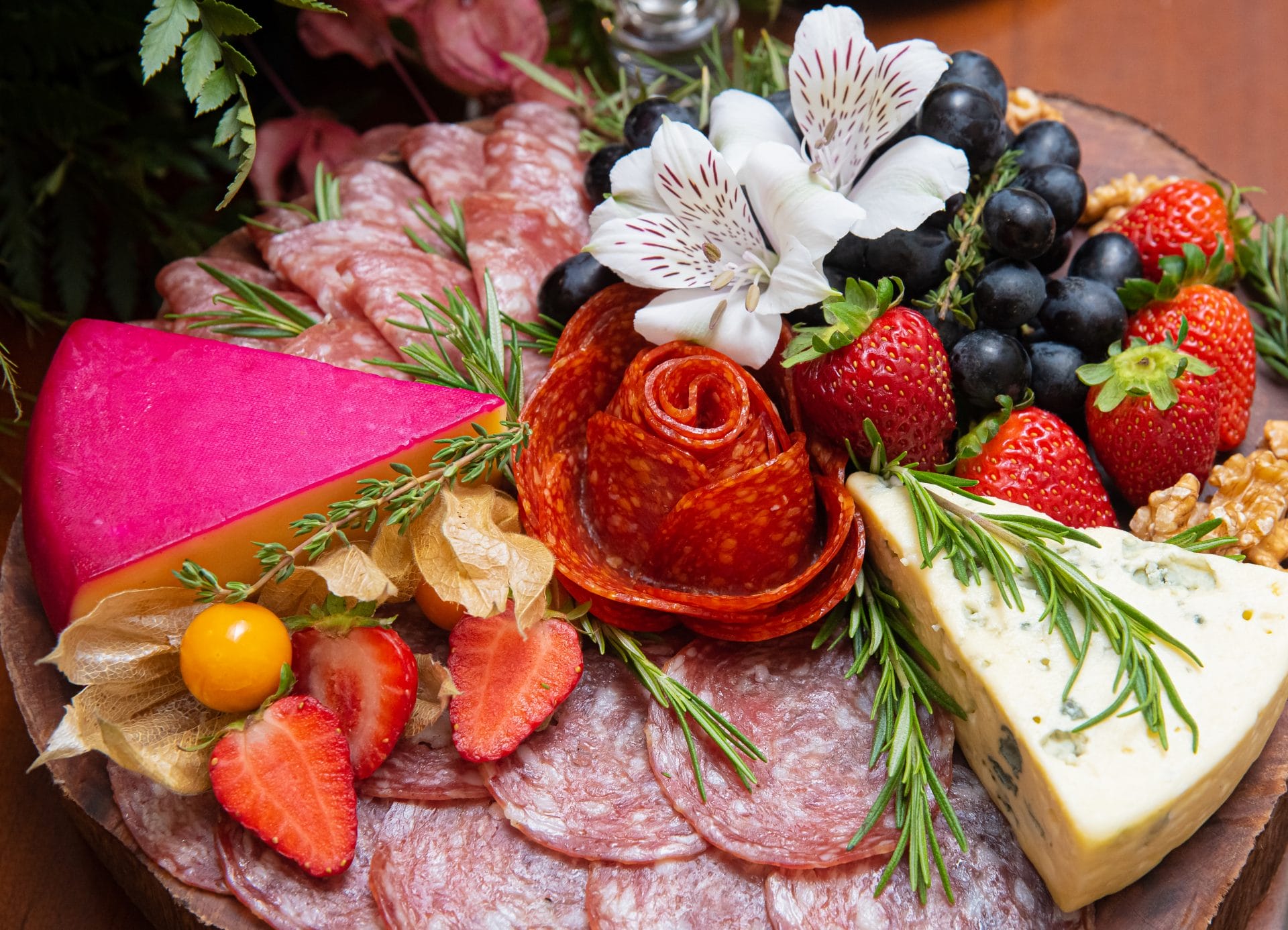
Types of Edible Flowers for Charcuterie Boards
Edible flowers can transform a charcuterie board from a simple spread into a visually stunning centerpiece. Their vibrant colors and delicate petals not only enhance the board's aesthetic appeal but also offer unique flavor profiles that can complement a variety of cheeses, meats, and fruits. In this section, we’ll explore some popular edible flowers that are perfect for charcuterie boards, highlighting their visual impact and flavor contributions. Whether you’re aiming for a vibrant springtime display or a sophisticated autumnal touch, these edible blooms will add an extra layer of elegance and taste to your culinary creation.
Popular Edible Flowers for Charcuterie Boards
1. Pansies
- Description: Pansies are small, delicate flowers available in a wide range of colors, including purples, yellows, blues, and whites. Their petals have a velvety texture, making them a visually appealing addition to charcuterie boards.
- Visual Reference:
2. Nasturtiums
- Description: Nasturtiums are vibrant flowers with a peppery flavor. They come in shades of red, orange, and yellow. Both the leaves and flowers are edible, adding a spicy kick to the board.
- Visual Reference:
3. Marigolds
- Description: Marigolds, particularly the Tagetes variety, are edible flowers with bright orange or yellow petals. They have a citrusy, slightly bitter flavor that can add a unique taste to the board.
- Visual Reference:
4. Violets
- Description: Violets are small flowers with a sweet, floral flavor. They are typically purple or blue but can also be found in white. Violets add a delicate touch and mild sweetness to the board.
- Visual Reference:
5. Lavender
- Description: Lavender has a strong, aromatic scent and a slightly sweet, floral flavor. Its purple buds can be used sparingly to add a distinctive aroma and taste.
- Visual Reference:
6. Borage
- Description: Borage flowers are star-shaped and typically blue, although pink and white varieties exist. They have a mild cucumber flavor, making them refreshing and unique.
- Visual Reference:
7. Begonias
- Description: Begonia flowers have a crisp texture and a tangy, citrusy flavor. They come in various bright colors and add a zesty note to the charcuterie board.
- Visual Reference:
Flavor Profiles and Pairing Suggestions
Pansies
- Flavor Profile: Mild, slightly grassy with a hint of wintergreen.
- Pairing Suggestions: Pansies pair well with soft cheeses like brie and camembert, as their mild flavor complements the creamy texture. They also work well with sweet elements like honey and berries.
Nasturtiums
- Flavor Profile: Peppery and spicy.
- Pairing Suggestions: The peppery taste of nasturtiums pairs nicely with sharp cheeses such as cheddar or gouda. They also enhance the flavor of cured meats like salami and prosciutto.
Marigolds
- Flavor Profile: Citrus-like, slightly bitter.
- Pairing Suggestions: Marigolds pair well with tangy cheeses like goat cheese and feta. Their citrusy notes also complement smoked meats and seafood.
Violets
- Flavor Profile: Sweet, floral.
- Pairing Suggestions: Violets are perfect with creamy cheeses like mascarpone and ricotta. Their sweetness pairs well with fresh fruits such as strawberries and grapes.
Lavender
- Flavor Profile: Strong, aromatic, sweet, and floral.
- Pairing Suggestions: Use lavender sparingly with rich, buttery cheeses like brie. It also pairs well with honey and dried fruits for a sweet contrast.
Borage
- Flavor Profile: Mild, cucumber-like.
- Pairing Suggestions: The refreshing flavor of borage pairs well with fresh cheeses like mozzarella and burrata. It also complements light, crispy crackers and fresh vegetables.
Begonias
- Flavor Profile: Tangy, citrusy.
- Pairing Suggestions: Begonias' tangy flavor pairs beautifully with creamy cheeses such as blue cheese and cream cheese. Their citrus notes also enhance the taste of smoked salmon and other seafood items.
By incorporating these edible flowers, you can not only elevate the visual appeal of your charcuterie board but also introduce new and exciting flavors that enhance the overall tasting experience.
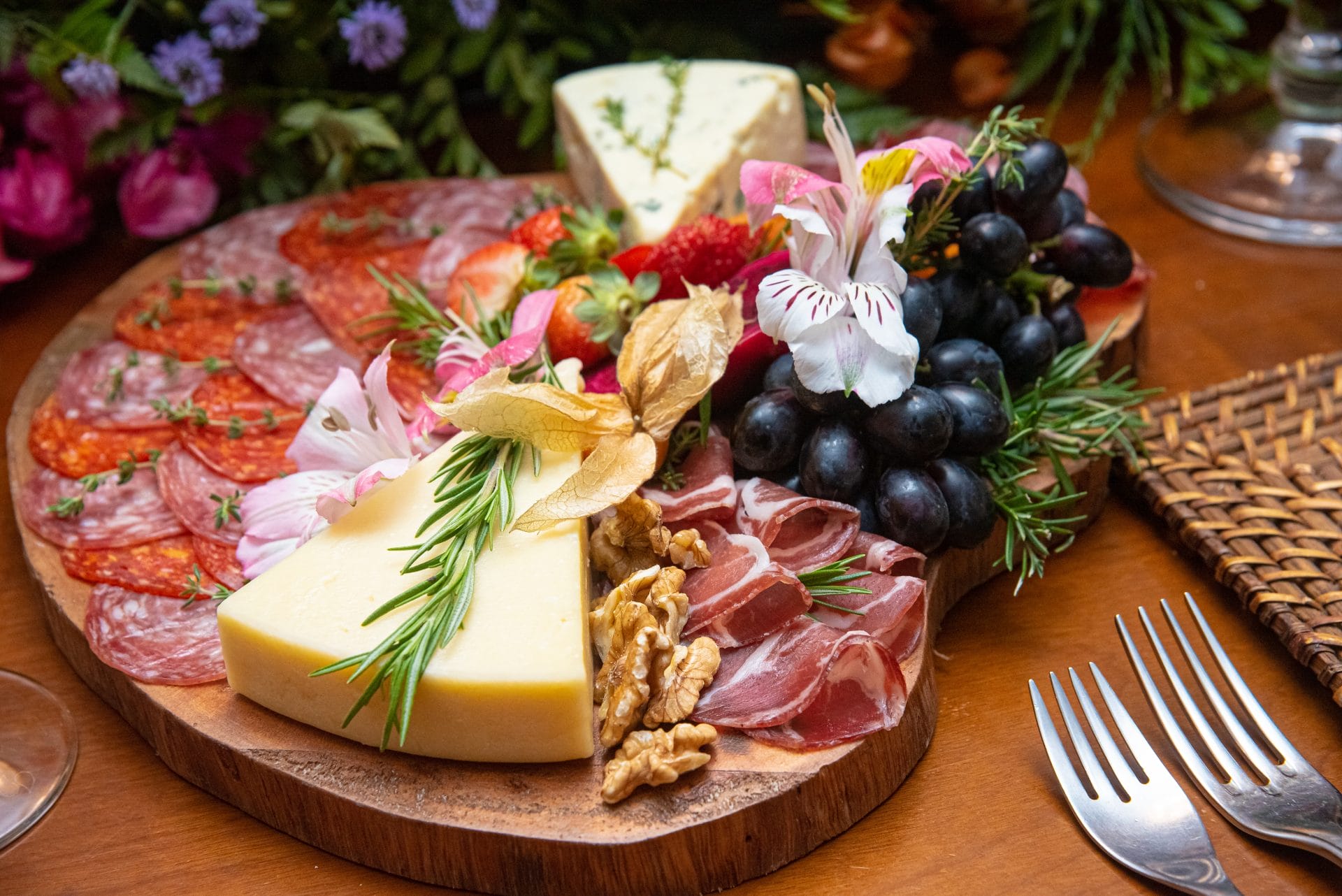
How to Decorate Your Charcuterie Board with Flowers
Decorating your charcuterie board with flowers is a creative way to enhance its visual appeal and elevate the dining experience. Flowers can add a burst of color, a touch of elegance, and even a hint of flavor to your spread. In this section, we’ll walk you through a step-by-step guide on arranging flowers, from selecting the right blooms to positioning them for the best effect. We’ll also explore some innovative flower arrangement ideas that can match any theme or season. Whether you're aiming for a subtle touch or a dramatic floral display, these tips will help you craft a beautiful and appetizing charcuterie board that will impress your guests.
Step-by-Step Decoration Guide
1. Choose Your Flowers
- Select a mix of fresh, edible flowers. Ensure they are pesticide-free and safe for consumption.
- Popular choices include pansies, nasturtiums, marigolds, violets, lavender, borage, and begonias.
2. Prepare the Flowers
- Rinse the flowers gently with cold water and pat them dry.
- Remove any inedible parts, such as stems or pistils, depending on the flower.
3. Plan Your Layout
- Decide on a central focal point for your board, such as a large piece of cheese or a bowl of dip.
- Arrange larger items first, such as cheeses, meats, and bowls, to create a foundation.
4. Add Fruits and Nuts
- Place fruits and nuts around the larger items, filling in gaps and adding texture.
5. Incorporate the Flowers
- Start by placing the flowers near the focal points to draw attention.
- Scatter smaller flowers around the board to create a balanced look.
- Group flowers in odd numbers (3, 5, 7) for a natural and pleasing arrangement.
6. Balance Colors and Textures
- Use a variety of colors to create contrast and interest.
- Mix different textures, such as soft petals with crunchy nuts or smooth fruits.
7. Final Touches
- Step back and assess the overall appearance.
- Adjust flower placement to ensure even distribution and visual harmony.
- Add fresh herbs like rosemary or thyme for additional greenery and aroma.
Creative Flower Arrangements
Themed Designs
- Romantic Theme: Use red and pink flowers, like roses and begonias, paired with chocolate and berries.
- Tropical Theme: Incorporate bright, exotic flowers like hibiscus and orchids with tropical fruits like pineapple and mango.
Seasonal Variations
- Spring: Use pastel-colored flowers like tulips and daffodils with fresh, seasonal fruits.
- Summer: Bright, vibrant flowers such as sunflowers and zinnias paired with berries and citrus fruits.
- Fall: Warm-toned flowers like marigolds and chrysanthemums with figs, nuts, and spiced meats.
- Winter: Use white and red flowers like poinsettias and camellias with winter fruits like pomegranates and pears.
Fresh vs. Dried Flowers
- Fresh Flowers: Add a vibrant, lively touch to your board. Best for immediate use.
- Dried Flowers: Offer a rustic, vintage feel. They are durable and can be prepared in advance. Lavender and rose petals are great dried options.
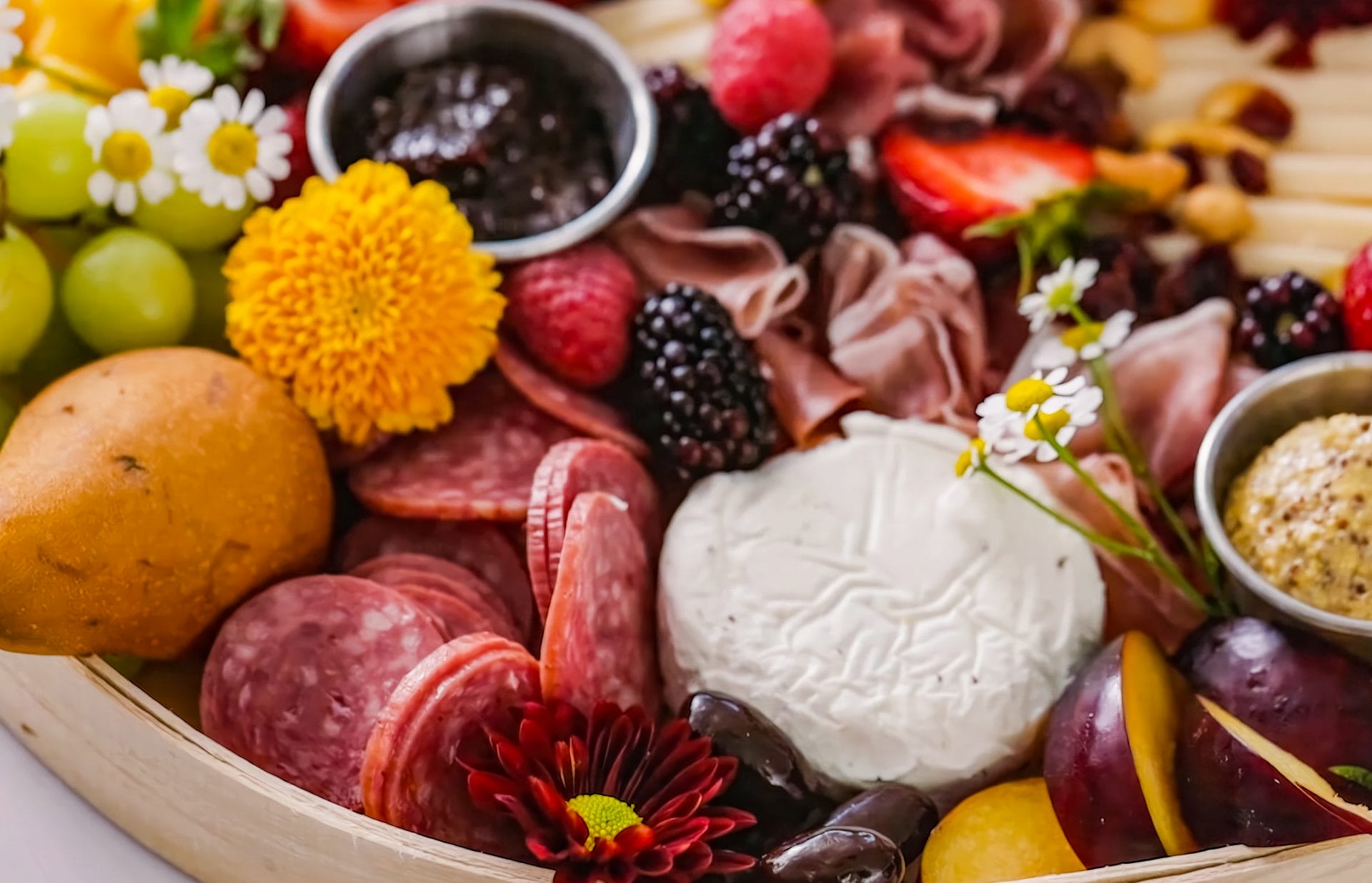
Best Flowers for Charcuterie Boards
Choosing the right flowers for your charcuterie board can make all the difference in creating a visually stunning and flavorful presentation. The best flowers not only enhance the aesthetic appeal with their vibrant colors and textures but also contribute unique flavors and aromas that can complement the various elements of your board. In this section, we'll highlight top flower choices that are both aesthetically pleasing and edible, ensuring that your charcuterie board is as delicious as it is beautiful. We’ll also delve into seasonal flower recommendations to help you make the most of what’s fresh and available throughout the year. Whether you're planning a spring celebration or a cozy winter gathering, these flower choices will add a special touch to your culinary masterpiece.
Top Flower Choices
Pansies
- Aesthetics: Available in a variety of vibrant colors, delicate and pretty.
- Edibility: Mild, slightly sweet flavor. Suitable for any type of charcuterie board.
Nasturtiums
- Aesthetics: Bright, bold colors with a unique shape.
- Edibility: Peppery, slightly spicy flavor. Great with cheeses and meats.
Marigolds
- Aesthetics: Warm, sunny colors like yellow and orange.
- Edibility: Citrus-like, slightly bitter taste. Pairs well with tangy cheeses and smoked meats.
Violets
- Aesthetics: Small, dainty flowers in shades of purple and blue.
- Edibility: Sweet, floral flavor. Complements creamy cheeses and fresh fruits.
Lavender
- Aesthetics: Elegant purple buds.
- Edibility: Strong, aromatic, sweet flavor. Use sparingly with rich cheeses and sweet condiments.
Borage
- Aesthetics: Star-shaped flowers, typically blue, sometimes pink or white.
- Edibility: Mild cucumber flavor. Ideal for pairing with light cheeses and fresh vegetables.
Begonias
- Aesthetics: Bright, cheerful flowers in various colors.
- Edibility: Tangy, citrusy flavor. Pairs beautifully with creamy cheeses and seafood.
Seasonal Flower Selection
Spring
- Flowers: Tulips, daffodils, pansies.
- Sourcing: Local farmers' markets or garden centers.
- Pairings: Fresh, young cheeses, spring fruits like strawberries, and light crackers.
Summer
- Flowers: Sunflowers, zinnias, nasturtiums.
- Sourcing: Local florists or pick-your-own flower farms.
- Pairings: Berries, tropical fruits, a variety of cheeses, and cured meats.
Fall
- Flowers: Marigolds, chrysanthemums, calendulas.
- Sourcing: Harvest festivals, local markets, or garden centers.
- Pairings: Seasonal fruits like figs and apples, nuts, and spiced meats.
Winter
- Flowers: Poinsettias, camellias, winter jasmine.
- Sourcing: Holiday markets, florists, or home gardens.
- Pairings: Winter fruits like pomegranates and pears, rich cheeses, and hearty meats.
Local Sourcing Tips
- Farmers' Markets: Many local farmers' markets offer seasonal flowers that are fresh and pesticide-free.
- Community Gardens: Joining a community garden can provide access to a variety of seasonal flowers.
- Grow Your Own: Planting a small garden or even potted flowers at home ensures a ready supply of fresh, edible flowers year-round.
By selecting flowers that are in season and locally sourced, you can create charcuterie boards that are not only beautiful and delicious but also sustainable and supportive of local agriculture.
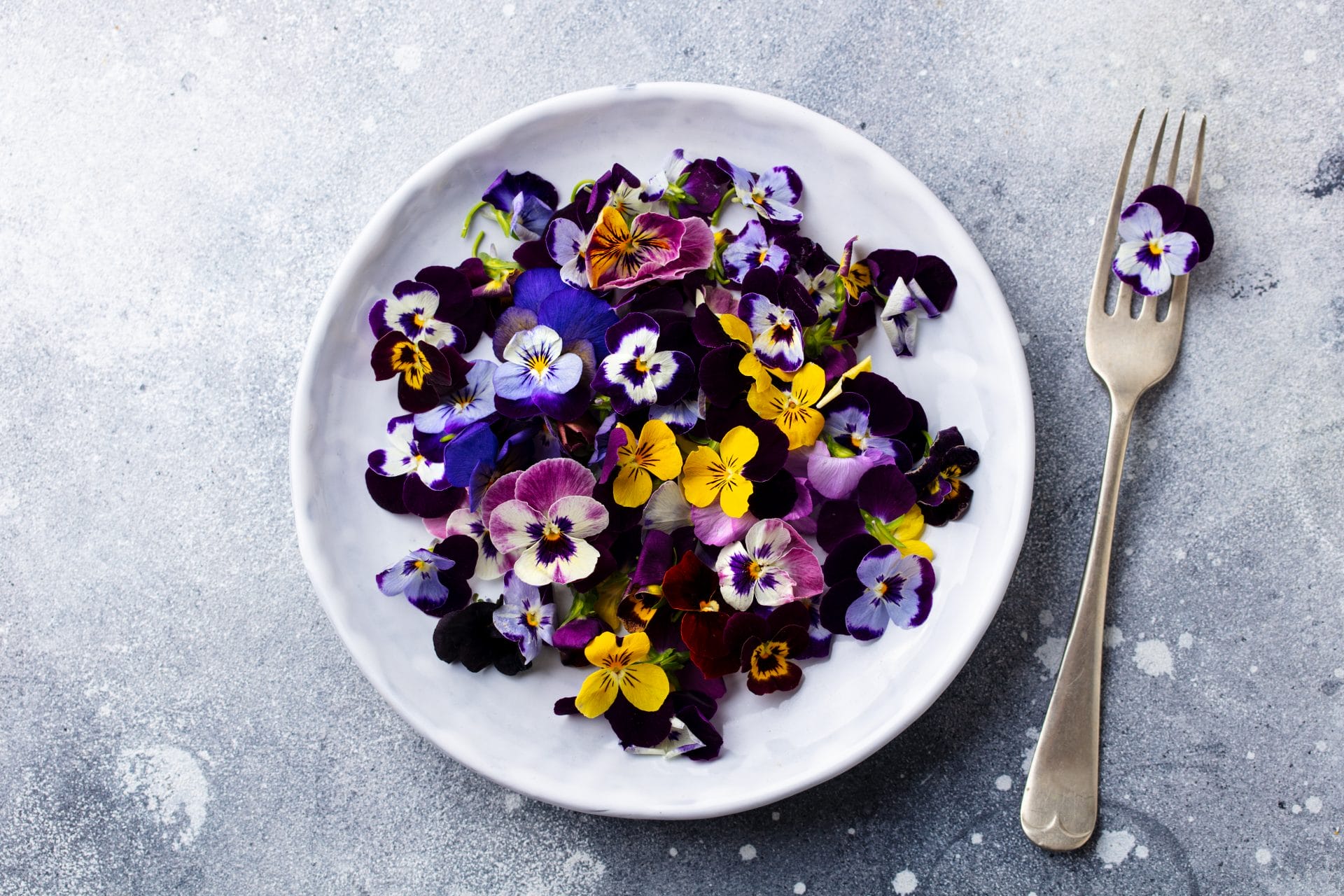
Combining Edible Flowers and Herbs
Elevate your charcuterie board by pairing edible flowers with complementary herbs, creating a harmonious blend of flavors and aesthetics. This combination not only enhances the visual appeal but also adds depth and variety to the taste experience. In this section, we'll explore which herbs work best with different edible flowers, and provide specific flower and herb combinations tailored to various themes and occasions. Whether you're aiming for a refreshing spring look or a cozy autumn vibe, these pairings will help you create a beautifully balanced and flavorful charcuterie board.
Complementary Herb Choices
1. Rosemary
- Flavor: Strong, pine-like aroma and a slightly bitter taste.
- Pairing Benefits: Rosemary's robust flavor complements savory meats and cheeses, adding a fragrant touch to the board.
2. Thyme
- Flavor: Earthy, slightly lemony.
- Pairing Benefits: Thyme's subtle citrus notes pair well with both sweet and savory elements, enhancing the overall complexity of the board.
3. Basil
- Flavor: Sweet, slightly peppery.
- Pairing Benefits: Basil's fresh and aromatic profile pairs wonderfully with tomatoes, soft cheeses, and fruits.
4. Mint
- Flavor: Refreshing, cool.
- Pairing Benefits: Mint adds a refreshing contrast to rich and creamy cheeses, as well as balancing the sweetness of fruits.
5. Dill
- Flavor: Fresh, slightly tangy.
- Pairing Benefits: Dill pairs well with smoked fish, soft cheeses, and cucumbers, adding a fresh, tangy flavor.
6. Sage
- Flavor: Earthy, slightly peppery.
- Pairing Benefits: Sage's bold flavor works well with hearty meats and aged cheeses.
7. Chives
- Flavor: Mild, onion-like.
- Pairing Benefits: Chives add a subtle onion flavor that complements creamy cheeses and savory elements.
Edible Flower and Herb Combinations
1. Romantic Theme
- Flowers: Roses, Pansies
- Herbs: Basil, Mint
- Enhancement: Roses and pansies add a delicate sweetness and vibrant color. Basil and mint provide refreshing, aromatic notes that balance the sweetness and add depth.
2. Tropical Theme
- Flowers: Hibiscus, Orchids
- Herbs: Mint, Cilantro
- Enhancement: Hibiscus and orchids bring exotic beauty and unique flavors. Mint and cilantro offer fresh, bright notes that enhance the tropical feel.
3. Rustic Fall Theme
- Flowers: Marigolds, Chrysanthemums
- Herbs: Sage, Thyme
- Enhancement: Marigolds and chrysanthemums add warm, autumnal colors and a hint of bitterness. Sage and thyme provide earthy, robust flavors that pair well with fall ingredients.
4. Spring Garden Theme
- Flowers: Tulips, Daffodils
- Herbs: Chives, Dill
- Enhancement: Tulips and daffodils bring cheerful colors and mild flavors. Chives and dill add a fresh, tangy taste that complements springtime cheeses and vegetables.
5. Winter Wonderland Theme
- Flowers: Poinsettias, Camellias
- Herbs: Rosemary, Lavender
- Enhancement: Poinsettias and camellias add festive color and elegance. Rosemary and lavender bring strong, aromatic notes that enhance the rich flavors of winter meats and cheeses.
6. Mediterranean Theme
- Flowers: Nasturtiums, Borage
- Herbs: Basil, Oregano
- Enhancement: Nasturtiums and borage add vibrant color and a peppery, cucumber-like flavor. Basil and oregano provide aromatic, savory notes that complement Mediterranean ingredients.
By combining edible flowers and herbs, you can create charcuterie boards that are not only visually stunning but also rich in layered flavors and aromas. These combinations elevate the overall experience, making each bite a delightful blend of taste and beauty.

Floral Arrangement Tips for Charcuterie Boards
Arranging flowers on a charcuterie board requires a blend of creativity and technique to achieve a visually appealing and cohesive presentation. This section offers practical tips for creating stunning floral arrangements, focusing on techniques for balancing colors, textures, and placement. We’ll discuss how to effectively use symmetry and asymmetry, layer elements for added depth, and incorporate flowers seamlessly into your board. Whether you're a seasoned host or a newcomer to charcuterie board design, these tips will help you elevate your presentation and impress your guests with beautifully arranged flowers.
Techniques for Stunning Floral Arrangements
1. Plan Your Layout
- Focal Points: Identify key areas of your board where you want to draw attention, such as the center or corners. Use larger flowers to create focal points.
- Balance: Distribute flowers evenly across the board to avoid overcrowding in one area. Balance large and small flowers for a harmonious look.
2. Color Coordination
- Complementary Colors: Choose flowers that complement the colors of your meats, cheeses, fruits, and other elements. For instance, use purple violets with yellow cheeses for a striking contrast.
- Seasonal Colors: Reflect the season with your color choices. Spring might call for pastels, while autumn could feature warm, earthy tones.
3. Symmetry and Asymmetry
- Symmetry: For a formal look, arrange flowers symmetrically around your board. Place similar flowers at equal distances from each other.
- Asymmetry: For a more natural, artistic feel, use asymmetrical arrangements. Cluster flowers in one corner or along one edge for a cascading effect.
4. Layering and Depth
- Layering: Place flowers at different heights to create depth. Use leaves or herbs as a base layer, with flowers positioned on top.
- Depth: Incorporate flowers at various points on the board, from the edges to the center, to create a sense of depth and fullness.
5. Flower Groupings
- Clusters: Group flowers in odd numbers (three, five, seven) for a natural appearance. Clusters can be spread across the board or concentrated in one area.
- Single Blooms: Use individual blooms to accent specific items, such as placing a single rose on a round of brie.
6. Garnishing
- Herbs: Use fresh herbs like rosemary or thyme alongside flowers for added greenery and aroma.
- Edible Petals: Scatter edible petals over the board for a delicate touch that complements the primary flowers.
Using Fresh vs. Dried Flowers
Fresh Flowers
- Benefits: Fresh flowers provide vibrant color, fragrance, and a sense of liveliness. They can also enhance the flavor of the charcuterie board when using edible varieties.
- Considerations: Fresh flowers are perishable and need to be used soon after picking. They require careful handling to avoid wilting.
- Storage Tips: Store fresh flowers in a cool place and keep them hydrated until just before arranging them on the board. Avoid placing them directly in the fridge with strong-smelling foods.
Dried Flowers
- Benefits: Dried flowers offer a rustic, timeless look and are longer-lasting than fresh flowers. They add texture and interest without the need for immediate use.
- Considerations: Dried flowers may not have the same vibrant colors or fragrance as fresh flowers. They can be more brittle and require gentle handling.
- Storage Tips: Store dried flowers in a dry, cool place, away from direct sunlight to prevent fading. Use airtight containers to maintain their condition.
By following these techniques and considering the unique benefits of fresh versus dried flowers, you can create stunning charcuterie boards that impress both visually and gastronomically.

Wrapping It Up
Adding flowers to charcuterie boards offers a multitude of benefits, from enhancing visual appeal with vibrant colors to adding unique flavors and fragrances. Edible flowers can elevate the presentation of your board, making it a feast for both the eyes and the palate. They also reflect a growing trend in culinary presentations, adding a touch of elegance and creativity to your gatherings.
We encourage you to experiment with different flowers and arrangements. Whether you opt for fresh blooms for their lively beauty and flavor or dried flowers for their rustic charm and durability, there are countless ways to customize your charcuterie board to fit any occasion or theme. Don’t be afraid to mix and match flowers with herbs to create unique and delightful combinations that will impress your guests. Happy decorating!
Frequently Asked Questions
Can you put flowers on a charcuterie board?
Yes, you can put flowers on a charcuterie board. Adding flowers, especially edible ones, can enhance the visual appeal and add unique flavors to your board. Ensure that the flowers are safe for consumption and free from pesticides. Popular edible flowers for charcuterie boards include pansies, nasturtiums, and marigolds.
How do you flower charcuterie?
To flower a charcuterie board, start by selecting fresh, edible flowers that complement your ingredients. Arrange the flowers in clusters around the board, balancing colors and textures. Place them near cheeses, fruits, and meats for visual appeal. Ensure the flowers are clean and pesticide-free. You can also mix in herbs for added fragrance and flavor. For a professional touch, use flowers to create a focal point or pattern that enhances the overall presentation.
How do you make a prettiest charcuterie board?
To make the prettiest charcuterie board, use a variety of cheeses, meats, fruits, and nuts. Add colorful edible flowers and fresh herbs for visual appeal. Arrange items thoughtfully, balancing colors and textures. Use a stylish board or platter to enhance the presentation.
Share Your Creations:
We’d love to see the charcuterie boards you create using our guide! Feel free to share your own creations in the comments or on social media, and tag us for a chance to be featured. And if you have any other ideas or tips for creating the perfect charcuterie board, we’d love to hear them.

